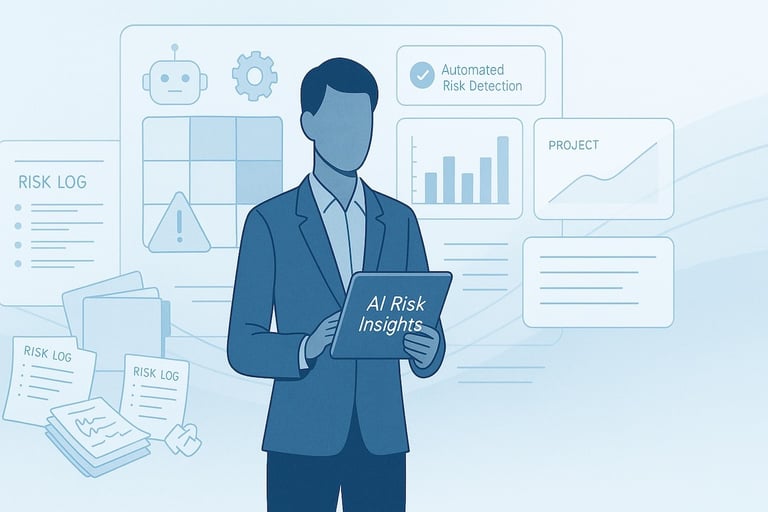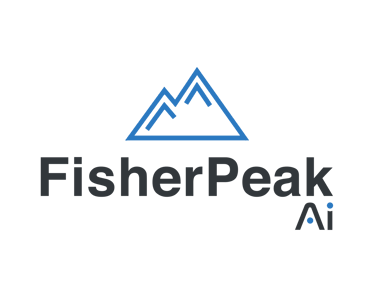Stop Guessing, Start Predicting: How AI Supercharges Risk Management
Discover how top PMOs are using AI to predict risks before they derail projects—and how you can start doing it today with tools you already have.
AI IN PROJECT MANAGEMENT
Grant DeCecco
6/2/20253 min read


Stop Guessing, Start Predicting: How AI Supercharges Risk Management
My name is Grant DeCecco, and I've spent the last 20 years helping organizations evolve through digital transformation. Today, I’m focused on the most significant shift of our time: how artificial intelligence is fundamentally reshaping the way we work, think, and solve problems.
In all my years of leading change, I’ve never seen a capability as impactful—and practical—as AI. Especially when it comes to project risk management.
If you’re still relying on spreadsheets, manual reviews, or gut instinct to manage project risk, this post is for you.
Traditional Risk Management Isn’t Enough
Most organizations do risk management like this:
Risks are logged inconsistently across teams
Risk logs are reviewed in lengthy meetings
There’s no unified view across projects
Decisions rely on human judgment alone
This approach creates blind spots and delays action. And in today’s fast-paced, interdependent project environments, those delays cost time, money, and trust.
AI Changes the Game
AI doesn’t just speed up risk analysis. It changes how we identify, prioritize, and act on risk.
Here’s what’s possible today:
Predictive Risk Detection
Tools like Wrike Work Intelligence or Asana AI analyze project data to flag emerging risks before they appear on a status report.Language-Aware Signal Scanning
AI can scan meeting notes, status comments, and chat messages for risk language. “Waiting on vendor” or “blocked by testing” becomes a trigger—not just noise.Dynamic Prioritization and Clustering
Instead of treating all risks equally, AI ranks them based on impact, probability, and related themes.Scenario Simulations
AI can model outcomes for delayed deliverables, resource conflicts, or budget changes—giving you options before issues escalate.
In one study, organizations using AI for project risk analysis saw a 15–27% reduction in overruns, thanks to earlier detection and faster response (source).
My Client Example: AI-Enabled Risk Visibility for a Fintech PMO
A fintech client had a common challenge:
Each project managed risks in its own format
PMs met in person with the enterprise risk team to review logs
There was no cross-project view of top risk themes
We solved this by combining several Microsoft tools:
SharePoint List: Central risk repository for all projects
Power Automate: Triggered AI analysis when risks were logged or updated
Microsoft Copilot: Generated qualitative summaries and flagged vague or missing information
Power BI: Surfaced risk trends, flagged inconsistent entries, and supported executive dashboards
What changed:
Risk documentation became more consistent
AI highlighted missing risks by comparing patterns
Meetings with ERM dropped by 50%—AI handled the first pass
Leaders gained visibility into cross-project risk themes for the first time
This wasn’t a pilot. It was production-ready and value-generating from month one.
Try It Yourself: AI Risk Review with a Custom GPT
To help you get hands-on, I created a basic example GPT assistant focused on project risk management:
👉 Project Management Assistant (Custom GPT)
It includes a sample risk log from five fictional projects. You can ask the GPT questions like:
"What are the top 5 risks across projects?"
"Which risks lack well defined mitigation plans?"
"Are there common risk themes?"
"What risks do not follow the PMO standard of If (event), Then (action)"
"Create a bar chart showing total number of risk with a score > 15 by project"
This is just a starting point. With tools like GPT, you can:
Automate first-level risk analysis
Standardize documentation across teams
Extract insights without hours of manual review
Sample Prompts for the Custom GPT
You can paste these directly into the GPT assistant:
“Summarize the highest priority risks across all five projects.”
“Identify any risks without mitigation strategies or poorly defined strategies”
“Group the risks by category (e.g., vendor, resource, compliance).”
“Suggest additional risks that might be missing based on project descriptions.”
“Highlight patterns in recurring risks over the last three projects.”
What You Can Do Today
If you’re ready to upgrade your approach to risk management, here’s where to start:
1. Centralize Your Risk Data
Start logging risks in a single source—whether it’s SharePoint, Airtable, or Notion.
2. Use AI to Analyze Qualitatively
Tools like ChatGPT, Copilot, or Claude can evaluate language, detect gaps, and cluster similar risks.
3. Automate with Triggers
Set up basic flows using Power Automate or Zapier. Example: Run analysis when a risk is created or updated.
4. Report More Effectively
Use Power BI or Looker Studio to visualize risks by category, owner, or likelihood—weekly, not quarterly.
5. Upskill Your Team
Teach your PMs how to use AI to improve—not replace—their judgment. Start with AI prompt training and regular risk review automation.
Final Thought
AI is not a magic solution. But it is a force multiplier.
It brings speed, consistency, and visibility to a process that has long been stuck in reactive mode.
If you want your PMO to lead—not lag—on risk, AI is no longer optional. It’s the next evolution of professional project management.
Want help applying AI in your PMO? Let’s talk. I offer workshops, playbooks, and implementation support that fit your tools and team.
— Grant
